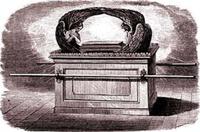Within the Holy of Holies, shielded from the eye of the common man, was one piece of furniture comprising two parts: the Ark of the Covenant and the atonement cover (or “mercy seat”) on top of it. The ark was a chest made of acacia wood, overlaid with pure gold inside and out. It was 3 feet, 9 inches long and 2 feet, 3 inches wide and high. God commanded Moses to put in the ark three items: a golden pot of manna, Aaron’s staff that had budded, and the two stone tablets on which the Ten Commandments were written. We will discuss these three objects in further detail below.
The atonement cover was the lid for the ark. On top of it stood two cherubim (angels) at the two ends, facing each other. The cherubim, symbols of God’s divine presence and power, were facing downward toward the ark with outstretched wings that covered the atonement cover. The whole structure was beaten out of one piece of pure gold. The atonement cover was God’s dwelling place in the tabernacle. It was His throne, flanked by angels. God said to Moses:
“There, above the cover between the two cherubim that are over the ark of the Testimony, I will meet with you and give you all my commands for the Israelites.” (Exodus 25:22)
“Tell your brother Aaron not to come whenever he chooses into the Most Holy Place behind the curtain in front of the atonement cover on the ark, or else he will die, because I appear in the cloud over the atonement cover.” (Leviticus 16:2)
Above the ark and the atonement cover, God appeared in His glory in “unapproachable light” (1 Timothy 6:16). This light is sometimes referred to as the Shekinah glory. The word Shekinah, although it does not appear in our English bibles, has the same roots as the word for tabernacle in Hebrew and refers to the presence of the Lord.
Because the ark was God’s throne among His people, it was a symbol of His presence and power with them wherever it went. There are quite a number of miracles recorded in the Old Testament surrounding the ark: With the presence of the ark, the waters of the River Jordan divided so the Israelites could cross on dry land, and the walls of Jericho fell so that the Israelites could capture it (Joshua 3:14-17, 6:6-21). Yet the ark could not be treated with irreverence because it was also a symbol of God’s judgment and wrath. When the Israelites fought their enemies the Philistines during the time of the prophet Samuel, they disregarded the commands of the Lord and took the ark out to the battlefield with them, “summoning” God’s presence. God caused the Philistines to win the battle and “the glory departed from Israel, for the ark of the Lord was taken” (1 Samuel 4:22). However, God showed His power to the Philistines when He caused their idol, Dagon, to fall to the ground when the ark was placed next to it, and several Philistine cities were plagued heavily when the ark was in their midst (1 Samuel 5). Ultimately, the ark was returned to Israel.

